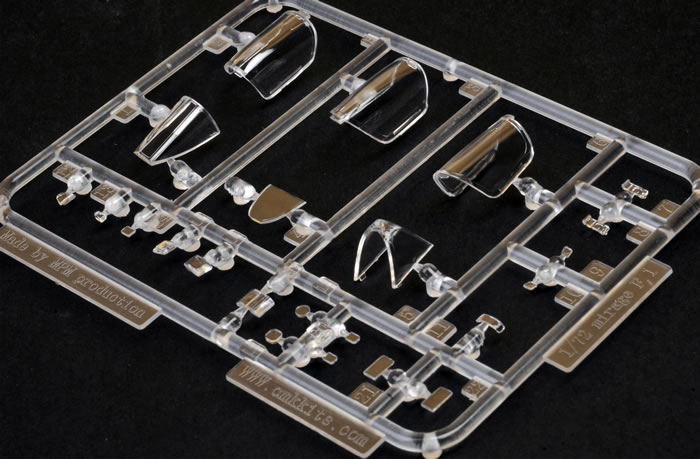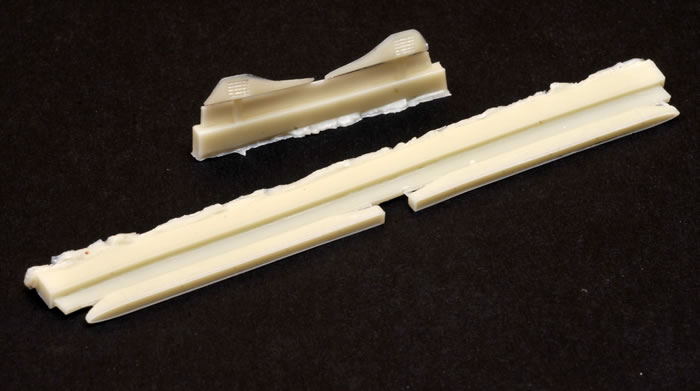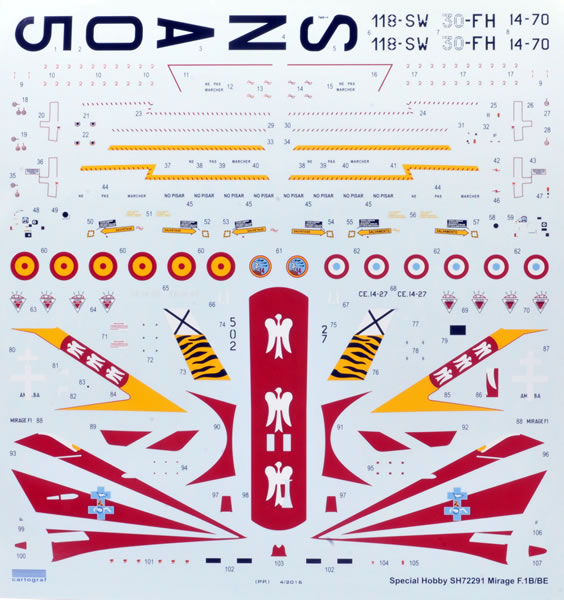|
Mirage F.1B/BE

Special Hobby, 1/72 scale
S u m m a r y : |
Catalogue Number: |
Special Hobby Kit No. SH72291 – Mirage F.1B/BE |
Scale: |
1/72 |
Contents & Media |
Sixty grey and ten clear styrene parts, four resin parts, with three decal options. (There are also numerous surplus parts.) |
Price: |
Available on-line from these stockists:
Click here for currency conversion |
Review Type: |
First Look. |
Advantages: |
Modern, refined, good detail and very good value. |
Disadvantages: |
Apparently some trimming for wing fit is needed according to build accounts. |
Conclusion: |
Special Hobby’s Mirage F.1 is an excellent quality kit with one or two easily surmountable fit issues according to the build articles I have read. These issues should not deter anyone from building what are clearly the best Mirage F.1 kits in “the One True Scale” available.
Pleasingly, Special Hobby chose to kit the two-seat F1.B, making only the second 1/72 scale kit of this version to be released. Even more pleasing is the fact that it comes with a complete two-seat fuselage rather than providing it as an add-on option to the single seat F.1C kit. I think that providing such a nice kit of a two-seat jet using only seventy parts is also a worthwhile achievement.
This is delightful kit of an understandably popular jet, I think it is tremendously good value and highly recommend it. |
Reviewed by Mark Davies

Special Hobby’s Mirage F.1B/BE is available online from Squadron.com
The Dassault Mirage F.1 is a French fighter and attack aircraft designed and built by Dassault Aviation as a successor of the Mirage III family. The Mirage F.1 entered service in the French Air Force (Armée de l'Air) in 1974. Powered by a single SNECMA Atar turbojet providing 15,000 lbs of thrust, the F.1 has been used as a light multipurpose fighter and has been exported to about a dozen nations. More than 720 F.1s have been produced.
Dassault designed the Mirage F.1 as a private venture, using its own funds, as a successor to its Mirage III and Mirage 5 fighters, with the F.1 being a smaller version of the Mirage F2 being developed for the French Air Force. It was of similar size to the delta-winged Mirage III and V, and was powered by a SNECMA Atar 9K turbojet as used in the Dassault Mirage IV, but unlike its predecessors, it shared the layout of a swept wing mounted high on the fuselage and a conventional tail surface as used by the F2. Although it has a smaller wingspan than the Mirage III, the F.1 nevertheless proved to be superior to its predecessor. It can carry up to 43% more fuel, has a shorter take-off run and better manoeuvrability.
The first prototype made its maiden flight on 23 December 1966. Despite the prototype crashing on 18 May 1967 due to flutter, killing its pilot, an order for three prototypes was placed on 26 May 1967, the larger and more expensive F2 being abandoned.
The French Air Force also ordered 20 Mirage F.1B, a two-seat operational conversion trainer; these were delivered between October 1980 and March 1983. The extra seat and controls added only 30 cm to the length of the fuselage, but at the cost of less internal fuel capacity and the loss of the internal cannon. The empty weight increased by 200 kg, partly due to the addition of two Martin-Baker Mk 10 zero-zero ejection seats, in place of the Mk 4 used in the F.1C, which had a forward speed limitation. In all other aspects the F.1B is a combat-capable aircraft and it can compensate for the lack of internal space by carrying external cannon pods and fuel tanks.
Source: Wikipedia
Previous 1/72 Scale Mirage F.1 kits
There have been four main single-seat Mirage F.1 kits in the past, these being from Heller (re-boxed by Airfix), Airfix (re-boxed by Heller and MPC), Hasegawa (re-boxed by Revell), and Esci (re-boxed by Italeri). Esci’s kit was the only one to feature recessed panel lines but sadly is quite inaccurate in many respects.
I have read varying opinions as to which of the kits is most accurate, as they all have their good and bad points. I think it’s best to avoid Esci and then pick a favourite from the other three based on your own research and which feature matters most to you. However, this is a bit of a moot point, as all of these kits have been clearly superseded by Special Hobby’s recent F.1C releases (boxed as a F.1CE & F.1CG so far, with others likely). These share many parts in common with the F.1B kit that is the subject of this “First Look”.
Until now, the only 1/72 F.1B kit was by Heller, where parts were provided for a single or twin seater in the same boxing (Note: some Heller boxings are the re-boxed Airfix tooling without a twin-seat option). Essentially, any considerations applying to Heller’s F.1C also apply to their F.1B. Heritage Aviation Models produced a F.1B conversion set with resin & white metal parts of indifferent quality and dreadful looking vac-canopies; it is best avoided based on the images I have seen of it.
Contents
The kit comes packed in a top-opening box with attractive art-work. The main sprues are in a re-sealable polythene bag, with the clear sprue, resin parts, and decals further enclosed in their own bags.
The instructions are an A5-sized booklet printed in colour on gloss paper with a brief aircraft history in Czech and English. The instructions include a parts map that identifies numerous surplus parts and use diagrammatic assembly stages.
The instructions are nicely produced and generally look clear enough to follow, but would benefit from using more pages with larger illustrations, as the entire assembly sequence is squeezed into just over two-and-a-half A5 pages. I suggest enlarging them and printing them on A4-sized sheets if you are over 40!
Detail colour call-outs are indicated by letters keyed to a table of colours with Gunze Aqueous and Mr. Color paint-codes. Four-view colours and markings diagrams are also provided within the instructions. These are nicely done and printed in colour, with generic colour names plus Gunze codes, whilst some include FS595 numbers as well.
The sprue gates are fine enough, and the mouldings are very crisp and clean. Special Hobby have previously been associated with limited run kits in the past; but this one has locating pins appears to be more long-run in nature. The clear sprue is crisp, with nice clear and acceptably thin canopies. The resin parts also appear flawless.
The Kit
The airframe surface detail is very nicely done with the delicate recessed panel lines with some appropriately raised panels around the wing-roots. The first impression on viewing the sprues is that this a very nicely engineered kit, and one that its designers have taken obvious pride in creating.
Cockpit detail is good for the scale, being more than adequate for a closed canopy model, and at least acceptable for the open option provided by the kit’s multi-piece canopy. Either way, I think most will wish to at least add seat harnesses to what are otherwise good ejection-seats for injection moulded items. Decals are provided for the two instrument panels which feature some 3D detail.

The instructions mention some CMK “Quick & Easy” detail enhancements sold separately; these being a resin exhaust nozzle and after-burner unit with PE flame holder, a pair of resin MB-10 seats with PE harnesses, and replacement resin wheels. (Also listed in the instructions are two Cyrano IV radar options, and single MB-4 and MB-10 seats; but these apply to the Mirage F.C kits.)
Assembly appears to be quite straight forward, especially given what is a low parts count for a relatively modern jet. This reflects some well thought out engineering, and the fact that Special Hobby chose to provide a complete two-seat fuselage, rather than the alternate cockpit and nose section approach often adopted by kit manufacturers.
I am unsure why the two wingtip missile rails and pair of chaff dispensers are provided as resin parts, as there is nothing about them that precludes their being moulded in styrene. Both apply to the Spanish markings option, so perhaps they were an afterthought once injection tooling was already completed.

I am far from a Mirage F.1 expert, but for me the kit captures the key elements of the real plane’s appearance very well. This includes the appealing overall shape, and distinct characteristics like the splayed main undercarriage legs. I have read a couple of magazine build articles about Special Hobby’s F.1C (Airfix Model World, August 2016, and Scale Aircraft Modelling, July 2016), and a very useful build log of the Mirage F.1B by Britmodeller’s “Mountain Goat”. He is clearly a Mirage F.1 fan with many useful observations, minor corrections and pertinent comments to make about Special Hobby’s F.1B; his build log can be viewed by clicking here.
There is a distinct air of quality to the whole kit, and one is left with the feeling it will be a breeze to build. However, this is not quite the case as some published build articles reveal. It seems that fit is generally very good, but the wing mounting tabs are too thick for the holes the must insert into. Also the base of the rudder leaves a too wide gap that simple shimming with plastic card can easily fix. So, some trimming and fit adjustment is needed, although from what I have read nothing is too demanding to remedy in order to get a good result.
Markings
Three appealing markings options are provided, two French and one Spanish.

The options are:
-
Mirage F.1B, 118-SW, No 502 Escadron de Reconnaissance 2/33 “Savoie”, BA 118 Mont de Marsan, June 2014.
-
Mirage F.1B, 30-FH, No 151 Escadron de Chasse 3/30 “Lorraine”, BA 112 Reims, September 1991.
-
Mirage F.1BE, 14-70, Matricular Militar C. 14-27, Ala de Caza no 14, Escuadron 142, Albacete – Los Llanos AB, Ejercito del Aire, 1988.
Scans of these colour schemes are included in the gallery image section above.
The decals appear to be superb in all respects, and are printed by Cartograf.
Special Hobby’s Mirage F.1 is an excellent quality kit with one or two easily surmountable fit issues according to the build articles I have read. These issues should not deter anyone from building what are clearly the best Mirage F.1 kits in “the One True Scale” available.
Pleasingly, Special Hobby chose to kit the two-seat F1.B, making only the second 1/72 scale kit of this version to be released. Even more pleasing is the fact that it comes with a complete two-seat fuselage rather than providing it as an add-on option to the single seat F.1C kit. I think that providing such a nice kit of a two-seat jet using only seventy parts is also a worthwhile achievement.
This is delightful kit of an understandably popular jet, I think it is tremendously good value and highly recommend it.
Thanks to Special Hobby for the review sample.
Review Text Copyright © 2016 by Mark Davies
Page Created 20 September, 2016
Last updated
21 September, 2016
Back to HyperScale Main Page
Back to Reviews Page |
